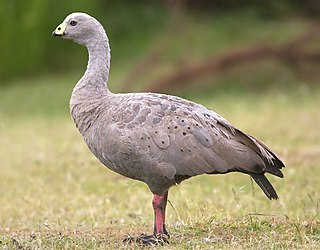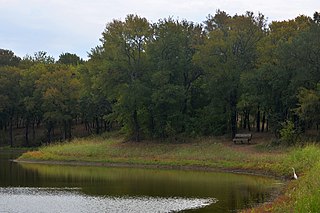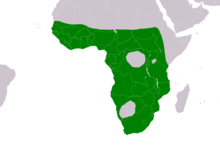
The nene, also known as the nēnē or the Hawaiian goose, is a species of bird endemic to the Hawaiian Islands. The nene is exclusively found in the wild on the islands of Oahu, Maui, Kauaʻi, Molokai, and Hawaiʻi. In 1957, it was designated as the official state bird of the state of Hawaiʻi.

The greylag goose or graylag goose is a species of large goose in the waterfowl family Anatidae and the type species of the genus Anser. It has mottled and barred grey and white plumage and an orange beak and pink legs. A large bird, it measures between 74 and 91 centimetres in length, with an average weight of 3.3 kilograms. Its distribution is widespread, with birds from the north of its range in Europe and Asia migrating southwards to spend the winter in warmer places. It is the ancestor of most breeds of domestic goose, having been domesticated at least as early as 1360 BCE. The genus name is from anser, the Latin for "goose".

The greater white-fronted goose is a species of goose related to the smaller lesser white-fronted goose. It is named for the patch of white feathers bordering the base of its bill: albifrons comes from the Latin albus "white" and frons "forehead". In Europe it has been known as the white-fronted goose; in North America it is known as the greater white-fronted goose, and this name is also increasingly adopted internationally. Even more distinctive are the salt-and-pepper markings on the breast of adult birds, which is why the goose is colloquially called the "specklebelly" in North America.

The snow goose is a species of goose native to North America. Both white and dark morphs exist, the latter often known as blue goose. Its name derives from the typically white plumage. The species was previously placed in the genus Chen, but is now typically included in the "gray goose" genus Anser.

The Anatidae are the biological family of water birds that includes ducks, geese, and swans. The family has a cosmopolitan distribution, occurring on all the world's continents except Antarctica. These birds are adapted for swimming, floating on the water surface, and in some cases diving in at least shallow water. The family contains around 174 species in 43 genera.

The Canada goose, sometimes called Canadian goose, is a large wild goose with a black head and neck, white cheeks, white under its chin, and a brown body. It is native to the arctic and temperate regions of North America, and it is occasionally found during migration across the Atlantic in northern Europe. It has been introduced to France, the United Kingdom, Ireland, Finland, Sweden, Denmark, New Zealand, Japan, Chile, Argentina, and the Falkland Islands. Like most geese, the Canada goose is primarily herbivorous and normally migratory; often found on or close to fresh water, the Canada goose is also common in brackish marshes, estuaries, and lagoons.

The emperor goose, also known as the beach goose or the painted goose, is a waterfowl species in the family Anatidae, which contains the ducks, geese, and swans. In the winter, the emperor goose lives in mudflats and coasts in Alaska and occasionally Canada and the contiguous United States. In the summer, it migrates northerly several hundred miles to arctic and sub-arctic climates, where older individuals breed monogamously. Listed as near threatened by the International Union for Conservation of Nature, the species' population is declining due to threats such as pollution, hunting, and climate change.

The wattled crane is a large, threatened species of crane found in wetlands and grasslands of eastern and southern Africa, ranging from Ethiopia to South Africa. It is sometimes placed in the monotypic genus Bugeranus.

The swan goose is a large goose with a natural breeding range in inland Mongolia, Northeast China, and the Russian Far East. It is migratory and winters mainly in central and eastern China. Vagrant birds are encountered in Japan and Korea, and more rarely in Kazakhstan, Laos, coastal Siberia, Taiwan, Thailand and Uzbekistan.

The Cape Barren goose is a large goose resident in southern Australia.

The ashy-headed goose is a species of waterfowl in tribe Tadornini of subfamily Anserinae. It is found in Argentina and Chile.

The ruddy-headed goose is a species of waterfowl in tribe Tadornini of subfamily Anserinae. It is found in Argentina, Chile, and the Falkland Islands.

The Orinoco goose is a Near Threatened species of waterfowl in the tribe Tadornini of subfamily Anserinae. It is found in every mainland South American country except Chile, French Guiana, Suriname, and Uruguay.

The kelp goose is a species of waterfowl in tribe Tadornini of subfamily Anserinae. It is found in Argentina, Chile, and the Falkland Islands.

The Fuegian steamer duck or the Magellanic flightless steamer duck, is a flightless duck native to South America. It belongs to the steamer duck genus Tachyeres. It inhabits the rocky coasts and coastal islands from southern Chile and Chiloé to Tierra del Fuego, switching to the adjacent sheltered bays and lakes further inland when breeding.

The southern screamer is a species of bird in family Anhimidae of the waterfowl order Anseriformes. It is found in Argentina, Bolivia, Brazil, Paraguay, Peru, and Uruguay.

Pilgrim geese is a breed of domestic goose. They are considered to be a relatively quiet, lightweight and medium-sized breed. The pilgrim goose is a rare and critically endangered species according to the American Livestock Breeds Conservancy (ALBC) and was officially entered into the American Poultry Association's Standard of Perfection in 1939. Generally, they can live for 15 to 25 years. In most breeds of geese, males and females are indistinguishable from one another; however, the pilgrim goose is well known for its auto-sexing trait. Males are characterised by white feathers while the females have grey. This sexual dimorphism makes pilgrim geese desirable for breeding as the sexes are easily determined. Their commercial use is primarily limited to the United States where they are bred for eggs and meat. They are known to grow relatively fast and are easy to handle.

Hagerman National Wildlife Refuge (HNWR), a haven for migratory birds and other wildlife, lies in northwestern Grayson County, Texas, on the Big Mineral Arm of Lake Texoma, on the Red River between Oklahoma and Texas. This National Wildlife Refuge is made up of water, marsh, and upland habitat. Visitors can hike, observe wildlife, hunt, and fish throughout the year.

A spur is an outgrowth of bone covered in a sheath of horn found in various anatomical locations in some animals. Unlike claws or nails, which grow from the tip of the toes, spurs form from other parts of the foot, usually in connection with joints where the toes meet the foot or the foot meets the long bones. Spurs are most commonly found on the hindfeet, though some birds possess spurs at the leading edge of the wings.

The bean goose is a goose that breeds in northern Europe and Eurosiberia. It has two distinct varieties, one inhabiting taiga habitats and one inhabiting tundra. These are recognised as separate species by the American Ornithologists' Union and the IOC, but are considered a single species by other authorities, such as the British Ornithologists' Union. It is migratory and winters further south in Europe and Asia.



























